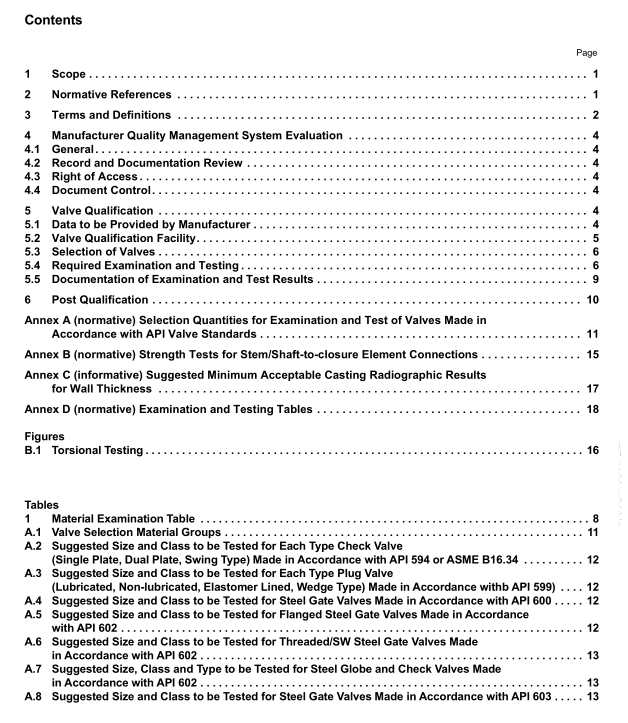API 591 pdf download

API 591 pdf download Process Valve Qualification Procedure
5.1.2 Where welding, including casting repair, is performed by the manufacturer and/or the foundry on the valves being evaluated, the applicable welding procedures and weld procedure qualification shall be provided.
5.1.3 The manufacturer shall make available a tabulation of the foundries and forge shops from which castings or forgings used for bodies, bonnets, covers, and closure elements (e.g. wedges, disks, plugs, or balls) were obtained and the manufacturing facilities from which completed valves were obtained. The table shall include any special marking or coding used by the manufacturer to trace, distinguish, and identify component parts from different sources, including each manufacturing location and address.
5.1.4 For gate and globe valves, the manufacturer shall provide the recommended closure torques to adequately seat the valve at the maximum rated pressure for all sizes of valves being evaluated. For quarter- turn valves, the manufacturer shall provide break-to-open and end-to-close torques at the maximum rated pressure. For bidirectional valves, the manufacturer shall provide torque values for both directions.
5.1.5 The manufacturer shall provide written certification, signed by an officer or senior-level manager responsible for quality control for the manufacturing company, that states that the manufacturer’s production valves, regardless of size, pressure class, or materials of construction, are equivalent to the valves involved in the qualification and comply with the applicable product standards.
5.1.6 The manufacturer shall identify the name and location of the facility where the valves undergo final assembly and testing for inclusion in the final report required by 5.5.
5.1.7 Manufacturing by a third party (private labeling), where the manufacturing facility does not fully own the name, trademark, or symbol on the valve, requires that the following additional information shall be documented in the final report prepared by the test facility:
a) owning entity of the trademark, valve design, casting patterns, or forging dies;
b) entity responsible for implementing the facility’s QMS/quality control program; and
c) the business relationship between the manufacturing facility(s) and the trademark owner (valve supplier, joint venture, partial ownership, majority of controlling ownership). A signed statement shall be included in the final report as required in 5.5.
5.2 Valve Qualification Facility The manufacturer shall engage a qualification facility to perform the inspections, examinations, and tests described in this section. The facility(s) used shall be mutually agreeable to the purchaser and the manufacturer. The qualification facility staff responsible for testing shall include a degreed or licensed metallurgical engineer or mechanical engineer. The qualification facility may subcontract portions of these inspections, examinations, and tests as required; however, subcontracting back to the valve manufacturer is not permitted. The qualification facility(s) shall be equipped and capable of performing or supervising the performance of nondestructive examination, physical tests, and chemical analyses on materials. The qualification facility staff shall be familiar with the applicable API valve standards and the codes, standards, and specifications referenced in those standards. The facility’s proposed program shall cover the following:
a) qualifications of the personnel performing the inspections and tests;
b) test details and format used to present the results of the tests;
c) number, sizes, and types of valves examined (see Annex A); and
5.3 Selection of Valves
5.3.1 In order to ensure that the test valves were not made specifically for the tests, a random sampling feature shall be incorporated into the program. The qualification facility personnel shall select the test valves randomly from the manufacturer’s or distributor’s stock. Alternatively, the purchaser may choose to select the valves to be tested.
5.3.2 Random sampling shall include selection from each material category to be qualified per Annex A. It is expected that the manufacturer shall have sufficient stock from which a random sampling of their valve products and shell materials to be qualified may be selected. A reduced number of valves from the recommended sample lot may be agreed upon by the purchaser and manufacturer. Selected valves shall be clearly identified. Once testing commences, testing shall be limited to the randomly selected sample lot with no substitutions.
5.3.3 Casting and forging materials qualification of shell components shall be in accordance with Annex A.
5.3.4 For nonstandard or built-to-order valves, these may be provided directly from the manufacturing facility to the qualification facility as agreed to by the purchaser. Quantity and specific test requirements are to be as agreed by the purchaser.
5.4 Required Examination and Testing
5.4.1 All of the pressure tests specified in API 598, including the optional high- or low-pressure closure tests, shall be performed on each valve. Subsequently, the valve shall be opened at the maximum rated differential pressure. After the pressure has been relieved, the seating surfaces shall be checked for damage. The double block and bleed test is required for valves identified by the manufacturer as being double block and bleed capable. The torque is to be applied by a calibrated torque wrench either directly or through a gear operator to the center of the stem/shaft. If the torque recommended by the manufacturer should prove to be inadequate, the torque may be increased incrementally to a maximum of 1.25 times the recommended value until the seat leakage is within allowable limits. The required closure torques shall be measured and reported. During seat tests, external forces that affect seat leakage shall not be applied to the valve ends.









